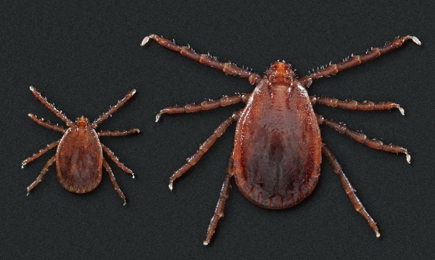Human bite leads to discovery of Asian longhorned ticks in New York

Asian longhorned ticks, which have been known to feed mainly on farm animals, particularly cattle, can transmit deadly diseases. In Asia, the longhorned ticks have infected humans with the potentially fatal disease SFTS (severe fever and thrombocytopenia syndrome). As of yet, no cases have been reported in the United States.
The tick species continues to spread, however, in the U.S. It was first identified on sheep in New Jersey in 2017. Since then, it has spread to 11 states, according to the Centers for Disease Control and Prevention (CDC). These include Arkansas, Connecticut, Kentucky, Maryland, North Carolina, New Jersey, Pennsylvania, Tennessee, West Virginia, Virginia and just recently, New York.
The Asian longhorned tick (H. longicornis) can carry Borrelia, the bacteria causing Lyme disease. And, according to the CDC, it can transmit the Heartland and Powassan viruses. “The full public health and agricultural (risk) of this tick discovery and spread is unknown,” stated Ben Beard, deputy director of CDC’s Division of Vector-Borne Diseases in a recent news release. [1]
Until last year, there had been no reported human cases of a longhorned tick bite. But on June 4, 2018, “longhorned ticks were identified following a human bite of a 66-year-old man from Yonkers, NY,” writes Wormser in the journal of Clinical Infectious Diseases. [2] The man did not become ill.
The Asian longhorned ticks were subsequently identified near the man’s home and at a nearby park and trail. “Ticks were collected in mowed short to mid-length grass near the trail edges, in both full sun and partial shade,” writes Wormser.
[bctt tweet=”The first human tick bite by an Asian longhorned tick leads to discovery of the tick species in New York State. ” username=”DrDanielCameron”]It took a human bite to identify the species in New York. “At the time these ticks were discovered,” writes Wormser, “they were the first known collections of H. longicornis in New York State.”
“Whether H. longicornis will pose a health risk for humans in the United States is unclear,” he adds.
“Another concern is whether H. longicornis might be able to transmit local United States pathogens such as the Heartland virus. In addition, there is some evidence that bites from H. longicornis ticks may lead to red meat allergy,” he points out.
The female Asian longhorn tick can reproduce thousands of eggs without a male tick.
Author’s Note: It took a person being bitten by the Asian longhorned tick to recognize their presence in New York State. Will it take another human tick bite to identify other tick species harboring new pathogens in the USA?
Related Articles:
Infected deer ticks moving into New York City
When should you worry about ticks in your neighborhood?
High prevalence of babesia microti in Suffolk County, New York
References:
- Asian longhorned tick spreading rapidly in the U.S. Centers for Disease Control and Prevention. November 29, 2018. https://www.cdc.gov/media/releases/2018/p1129-tick-spreading-widely.html
- Wormser GP, McKenna D, Piedmonte N, et al. First Recognized Human Bite in the United States by the Asian Longhorned Tick, Haemaphysalislongicornis. Clin Infect Dis. 2019.




Join the Lyme Conversation
(Note: comments are moderated. You will see your comment after it has been reviewed.)